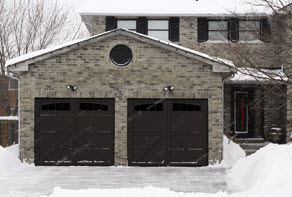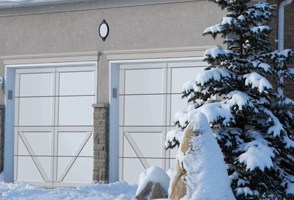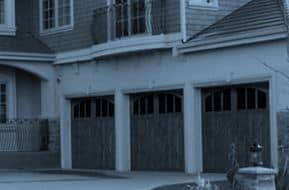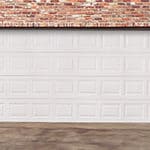In many instances, the garage door is the single largest moving part in a home. Garage doors require proper maintenance to ensure their continued functionality and convenience. While major repairs should be left to the experts, such a spring replacements, every homeowner should conduct regular basic maintenance and inspections to spot problems before they become serious. The following maintenance tasks are well within the reach of the average homeowner, and should be performed regularly.
1. Lubricating the Moving Parts
In efforts to extending the lifespan of your garage door system, be sure to keep the rollers, hinges, and other moving parts well lubricated. This will help limit the stress on the door and door opener. Bi-annually, we suggest apply a high-quality spray lubricant, such as white lithium grease spray, on the rollers and hinges. Be sure to clean off any excess. A penetrating solution may be required for any rollers or hinges that seem to be seized up. Once freed, apply the lithium grease.
In addition to the rollers and hinges, its important to lubricate the spring system. This includes the pulleys on extension-spring setups and the bearings on torsion-spring setups. Spay oil across the torsion spring to keep it running smoothly. If your garage door opener utilizes a screw or chain, Lubricate these as well. Do not use lubricant on a belt-drive opener.
2. Inspect the Tracks
Inspect the tracks on both sides of the door to make sure they are free of debris and rust. Dirt and dust can build up on the track and lead to premature failure of your rollers, springs or bearings. A damp cloth will take care of most of the cleaning needs here. For sticky residue, use a solvent metal cleaner. If you live in a cold climate, snow and ice in the track may also be a concern. You can also use a level to make sure the tracks are perfectly vertical along their vertical sections. While minor adjustments can be a DIY project, any major track adjustments should be trusted to the professionals.
3. Repair or Replace Weatherstripping
Looking to save energy? Inspect your weatherstripping. The rubber weatherstripping around the door opening and on the bottom of the door helps keep out the cold as well as water, dust, and dirt. There are several ways the seal at the bottom of the door can be attached, dependent on the garage door model. If this is torn, damaged, or missing, look to have it replaced. The weatherseal around the door opening comes in many different colors to match your door and home style.
4. Inspect the Garage Door Opener Safety Features
All residential garage door openers manufactured after 1993 should have an auto-reverse feature that is designed to stop and reverse the direction of the door if it detects an object in the path of the door or it hits an object while the door is closing. This safety feature is activated by a force setting or by a pair of safety eyes on each side of the door. These eyes should be located no higher than 6″ from the floor.
Test the force setting by placing a 2×4 board flat on the ground in the path of the door. When the door comes down and touches the 2×4, it should reverse direction and return to the open position. Test the safety eyes by starting to close the door, then passing your leg in the door’s path. The door should reverse direction and return to the open position. If your garage door opener does not have these features, we suggest replacing it.
5. Test the Door Balance
To ensure the safety and well being of your garage door and garage door opener, regularly inspect the doors balance. If your garage door is not properly balanced, the garage door opener will have to work harder, shortening the lifespan. Test the balance by pulling the release handle on the garage door opener, placing it in manual mode. Then manually place the door halfway open. The door should remain in place. If the door begins to drop or raise, the door is improperly balanced or the springs are beginning to wear out. Trust all spring repairs to a professional.
6. Tighten all Hardware
The vibration and motion caused by the garage door consistently moving up and down can result in loose hardware over an extended period of time. Inspect all of the track brackets and door fasteners to ensure everything is tight. Use a socket wrench to tighten up any loose bolts you find.
 When temperatures start dropping, your garage becomes more than a place to simply store your vehicle; it becomes your first respite from the chill. When a garage door is malfunctioning due to the cold, it is going to keep you from safely pulling your vehicle inside. Unfortunately, cold weather garage door problems are very common. By knowing what problems you may be encountering and how to approach them, you can be back by the fireplace in no time.
When temperatures start dropping, your garage becomes more than a place to simply store your vehicle; it becomes your first respite from the chill. When a garage door is malfunctioning due to the cold, it is going to keep you from safely pulling your vehicle inside. Unfortunately, cold weather garage door problems are very common. By knowing what problems you may be encountering and how to approach them, you can be back by the fireplace in no time.
Common Garage Door Problems:
Excess Grease
Excess grease on your garage door tracks is a problem that can occur any time of the year, but it can really start causing issues in the winter. Too much lubrication can throw your rollers out of alignment, making it difficult for the door to open and close smoothly. Finding the balance between enough lubrication and too much is one of the most important parts of garage door maintenance.
Contracting Metal
Certain materials contract when temperatures dip below a certain threshold. Metal is one of these materials, meaning that it’s not uncommon for a garage door’s springs, screws and other metallic components to shrink and seize up in the winter months. You can’t keep this phenomenon from happening, but you can mitigate its effects by adding more lubricant. Apply plenty of garage door oil to the springs, the torsion ball bearings and the screw drive. Keep oil away from the tracks to avoid the first problem mentioned.
Thickening Grease
Most lubricating greases are designed to operate under extremely hot conditions. This is what makes them so effective in the high-power conditions found in engines. Unfortunately, lubricants don’t necessarily work as well when subjected to the cold. Low temperatures can harden grease, thickening it to the point where it makes a very poor lubricant. Make sure this hasn’t happened in your garage door. Remove old, hardened grease with an applicable solvent, and replace it with a silicone-based oil for better winter results.
The best approach to preventing garage door problems in the winter is to stay on top of regular maintenance. Regular lubrication, consistent cleaning and careful usage should keep your garage door functioning until spring arrives.
Cold winter temperatures and snowy weather are tough on your home’s exterior, causing damage to the roof, windows, doors and seals if you’re not partaking in proper preventative maintenance. However, many homeowners don’t realize that these extreme conditions can also wreak havoc on your garage door. There are a few issues that are common in areas that experience harsh winters, but you can avoid expensive garage door repair if you keep your eyes open for the warning signs.
Seals and Weather Stripping

As you drive into your garage, your car tires bring snow and water in with them. In addition, snow piles up outside the garage door during winter storms. In both cases, the moisture adheres to the seal or weather stripping at the bottom of the garage door. Then, when you open the door, the seal may rip and detach from the bottom. To avoid needing weather seal replacement services, sweep the snow away from the area as often as possible.
Broken Springs
Frigid temperatures cause metal to become hard and brittle, including the springs. If you have difficulty opening your garage door and it feels heavy, you may have a broken spring. Only a qualified garage door repair expert should replace a broken spring.
Garage Door Drive Track
The drive tracks are the two long strips on each side of your garage door that guide it into place as it raises and lowers. When they become obstructed by debris, the door will jam. Keep them free of obstructions by brushing the drive track frequently, especially during winter when sand and salt are used to remove snow and ice on roads.
Other problems can arise when winter weather strikes, but being aware of the most common issues can help you catch many of these concerns before they become serious. Preventative maintenance and regular inspections should be performed yearly at a minimum. Recognizing these issues will not only save you money, but also can prolong the life of your garage door.
 When you are a homeowner, it is good to have an understanding of how things work so you are able to take care of the upkeep on your own. This can save you significantly with repair costs. A big issue people have is with their garage door functioning when the weather turns cold. Below are a few details to keep in mind.
When you are a homeowner, it is good to have an understanding of how things work so you are able to take care of the upkeep on your own. This can save you significantly with repair costs. A big issue people have is with their garage door functioning when the weather turns cold. Below are a few details to keep in mind.
Vacation Lock
Is your vacation lock causing your garage door opener not to function properly? Many garage door openers offer a vacation lock located on the wall console. This switch is used as an extra security function and stops all electrical operation of the opener once the door is closed. This button should only be used when you are away from the door for an extended period of time. Be sure to check this switch to see it is in the off position.
Door Sensors Need Alignment
One of the issues that could be occurring is that the photo eyes are out of place. Something as simple as a trashcan bumping them can cause this to happen. Usually the fix is as simple as readjusting the photo eyes into the correct alignment and the opener will operator again.
Broken Spring
When the weather begins to change and the temperatures begin to drop, your garage door springs are more likely to break when reaching their life span. When this occurs, it is important to contact a professional repair service. Operating a garage door with a broken spring can be very difficult to do and can cause further damage to the garage door opener. The spring is a vital part to making your garage door system function properly and should be kept in good order at all times. Only trained professionals should perform repairs of this nature, for the spring holds an extreme amount of tension that can cause serious injury if mishandled.
How to Figure Out the Problem
When your garage door opener is not functioning properly, always be sure to check the basics. First, be sure that if your wall console offers a vacation lock, this is in the off position and is not engaged. Secondly, be sure that the sensors are in place. If there are led lights blinking, it is possible the photo eyes are out of alignment or they have been damaged and need to be replaced. Finally, inspect your garage door for a broken spring. If you believe your garage door spring has broken and the door is in an open position, call a professional repair service immediately. Do not pass under the door under any circumstances.
Regularly maintaining your garage door has many benefits and should be done on an annual basis. This includes testing the balance and alignment of your door and the safety reversal of your opener. Make sure you read through the owners’ manual to find out any other maintenance that may be required.
 As you pull into the drive after a long day of work and press that garage door button, the last thing you want is to have your garage door fail to open. If the torsion spring is the culprit, you’re facing the need for professional repair. When garage door springs break, many homeowners are left scratching their heads, wondering where they went wrong.
As you pull into the drive after a long day of work and press that garage door button, the last thing you want is to have your garage door fail to open. If the torsion spring is the culprit, you’re facing the need for professional repair. When garage door springs break, many homeowners are left scratching their heads, wondering where they went wrong.
These common problems can lead to damage to the torsion spring and, ultimately, failure of your garage door.
Rust on the Spring
If the spring develops rust, it’s going to lead to failure. When the spring has rust on it, it increases the friction on the coil. It also corrodes the coil and weakens the spring. The good news is you can prevent rust by spraying the coil with some lubricant every three or four months. This will lubricate the spring and prevent rust from building up on it.
Incorrect Springs
Each garage door has a specific spring that is engeneered to operator the door. If the spring being used with your door is not the specified spring length and wire size, it is likely to break and cause failure more quickly.
General Wear and Tear
The most common reason for failure in a garage door torsion spring is simple wear and tear. Torsion springs only last a set period of time. In general, they are rated for about ten thousand cycles, which is one up and down cycle. So, you go through at least two cycles every day, one when you leave in the morning, and one when you return. Most families go through many more than two cycles a day. You could easily use up your ten thousand cycles in just a few number of years.
If you know your family is going to be heavy on the garage door use, consider investing in extended lifespan torsion springs. These will last up to four times as long, and only cost about two times the cost, so the investment is worthwhile.
Poor Maintenance
The last problem you could have with your torsion spring is poor maintenance. The better you maintain your door, the longer the lifespan of your torsion spring will be. In addition to lubricating your door, make sure the door is balanced. To test balance, lift up the door to the halfway point, then release. If the springs are in balance, the door will be still. If you notice problems with balance, have the springs inspected to ensure that you don’t end up with a failure and a car stuck in your garage.
 Nowadays, it is hard to shop for any product without having a variety of styles to choose from. Browsing a car dealership can overwhelm you with options like speed capability, 4-wheel drive, color, make, model, etc. Bath towel shopping has you pondering between cotton and linen. Even purchasing jeans can be a monotonous decision – do you want dark or light, bootleg or skinny?
Nowadays, it is hard to shop for any product without having a variety of styles to choose from. Browsing a car dealership can overwhelm you with options like speed capability, 4-wheel drive, color, make, model, etc. Bath towel shopping has you pondering between cotton and linen. Even purchasing jeans can be a monotonous decision – do you want dark or light, bootleg or skinny?
That being said, homeowners should not be surprised that garage door shopping also requires an extensive decision-making process. (more…)
